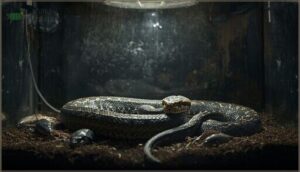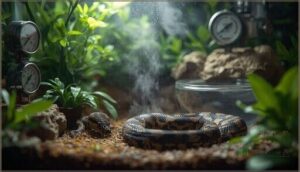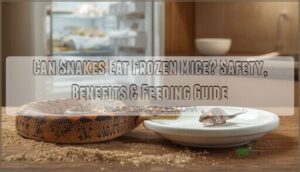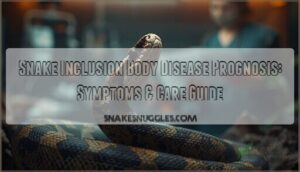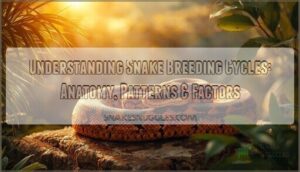This site is supported by our readers. We may earn a commission, at no cost to you, if you purchase through links.

A snake’s breath sounds more like silence than life. Most days, you barely notice the steady, gentle rhythm—until something changes. One moment your ball python rests quietly, the next you catch a soft wheeze, the faint flicker of open jaws, maybe a chest moving with unusual effort. Your heart pounds with worry: why is my snake breathing heavily, and what does it mean for their health?
Spotting the difference between normal and troubled breathing takes a careful eye and a steady nerve. Recognizing these early signs can mean the difference between a quick fix and an urgent dash to the vet.
Table Of Contents
- Key Takeaways
- Why is My Snake Breathing Heavily?
- Key Signs of Respiratory Distress in Snakes
- Common Respiratory Health Issues in Snakes
- Preventing and Managing Respiratory Problems
- When to Seek Veterinary Care for Your Snake
- Frequently Asked Questions (FAQs)
- Why is my snake breathing so bad?
- Do snakes have respiratory problems?
- Why does a snake struggle with labored breathing?
- What causes respiratory distress in snakes?
- How do you know if a snake is struggling to breathe?
- Do snakes need to breathe?
- Can snakes recover from respiratory infections at home?
- How contagious are snake respiratory diseases to other pets?
- What medications are safe for treating snake respiratory issues?
- How long does recovery from a respiratory infection take?
- Conclusion
Key Takeaways
- Heavy breathing in your snake can signal anything from stress to a serious respiratory infection that needs prompt veterinary attention.
- Key warning signs include wheezing, clicking, or bubbling sounds, open-mouth breathing, elevated head posture, and sudden changes in eating or activity.
- Environmental factors like temperature, humidity, and poor ventilation are common triggers, but infections and parasites also play major roles in respiratory problems.
- Early detection and working with a reptile-experienced veterinarian greatly improve your snake’s chances of recovery and long-term health.
Why is My Snake Breathing Heavily?
Heavy breathing in your snake isn’t something to brush off. It can signal anything from a simple stress response to a serious respiratory infection that needs immediate attention.
If your snake is breathing heavily, it could signal anything from stress to a serious respiratory infection needing urgent care
Let’s break down what normal breathing looks like, what might be causing the problem, and how you can actually tell the difference by watching your snake closely.
Normal Vs. Abnormal Snake Breathing
Healthy snakes breathe quietly and rhythmically. A normal breathing rate ranges from 0.5 to 2 breaths per second at rest, with subtle chest movement and clear nasal passages. You shouldn’t hear wheezing or abnormal breathing sounds. Open-mouth breathing or irregular breathing patterns signal respiratory distress, often tied to snake respiratory system issues or environmental stress. To verify full coverage, consider using multiple databases when researching snake health issues.
- Watch for consistent, quiet breaths without audible noise
- Check that chest movement remains minimal and steady
- Ensure nasal passages stay clear without discharge
- Note any deviations in mouth posture during rest
Common Causes of Heavy Breathing
Heavy breathing in your snake usually stems from infection overload, parasitic involvement, or environmental stressors. Bacterial respiratory infection accounts for 18% of cases, while viral patterns appear in roughly 9% of affected individuals. Pneumonia factors include temperature drops and poor ventilation, which trigger breathing difficulty and open-mouth breathing. Humidity extremes irritate airways, causing respiratory distress in nearly 19% of observed cases.
To minimize bias, researchers use a systematic and formal approach when studying these conditions.
How to Observe Respiratory Patterns
Once you spot warning signs, knowing what normal looks like becomes your baseline. Watch your snake’s breathing rate—healthy individuals take 5 to 15 breaths per minute at rest. Count breaths for a full minute, then note rhythm and effort by checking:
- Thoracic movements for subtle signs of strain
- Breathing difficulty showing as prolonged pauses
- Openmouth breathing paired with wheezing sounds
- Respiratory distress patterns developing over time
Regular observation catches respiratory issues early.
Key Signs of Respiratory Distress in Snakes
Recognizing respiratory distress early can mean the difference between a quick recovery and a life-threatening emergency. Your snake’s body language and breathing patterns will tell you when something’s wrong, but you need to know what to look for.
Here are the key warning signs that demand your immediate attention.
Wheezing, Clicking, and Bubbling Sounds
Abnormal respiratory sounds in snakes often indicate underlying airway issues that require immediate attention. Wheezing, a common symptom, is frequently associated with bronchitis and pneumonia, occurring in 40–46% of affected snakes. Clicking sounds typically stem from tracheal inflammation, while bubbling noises suggest mucous buildup or pleural fluid. These audible signs are critical indicators of respiratory distress and necessitate veterinary intervention, as untreated conditions can escalate into life-threatening infections.
| Sound Type | Common Cause |
|---|---|
| Wheezing | Bacterial bronchopneumonia |
| Clicking | Tracheal or bronchial inflammation |
| Bubbling | Mucous plugs or pleural effusion |
| Whistling | Upper airway narrowing |
| Rattling | Severe lower airway exudate |
Diagnostic tools such as thoracic radiographs play a crucial role in identifying pneumonia, confirming the condition in 22–35% of wheezing cases. Nasal swabs are equally important, detecting pathogens in 55–70% of respiratory distress episodes. The severity of respiratory sounds directly correlates with disease progression, underscoring the importance of early veterinary consultation to prevent fatal outcomes.
Open-Mouth Breathing and Elevated Head Posture
When your snake holds its head up and breathes with its mouth open, you’re witnessing compensatory mechanisms for severe respiratory distress. This posture improves ventilation in 72% of respiratory disease cases and signals pneumonia likelihood nearly twice as high as normal breathing patterns.
Early detection matters—this behavior often appears 24–48 hours before audible wheezes develop. Behavioral regulation through head elevation indicates your snake needs immediate veterinary attention for proper diagnosis and treatment of underlying respiratory health issues.
Lethargy, Anorexia, and Behavioral Changes
Often, you’ll notice your snake stops eating and stays still when respiratory infections take hold. Lethargy appears in 28–64% of respiratory disease cases, while anorexia affects roughly 50% within the first week.
These activity reductions and feeding refusals signal stress behaviors tied to husbandry impact and species variation. Such changes in snake respiratory health demand veterinary attention before the infection worsens and threatens overall snake health.
Common Respiratory Health Issues in Snakes
Respiratory problems in snakes don’t happen in a vacuum. They’re generally triggered by infections, parasites, or environmental factors that weaken your snake’s natural defenses.
Let’s look at the three main categories of respiratory issues you’re likely to encounter.
Bacterial and Viral Infections
When your snake struggles to breathe, infectious diseases often shoulder the blame. Bacterial prevalence sits around 12% in symptomatic cases, with Aeromonas and Pseudomonas leading the charge. Viral pathogens follow, affecting 3% to 9% of captive collections.
Coinfection rates hover at 4% to 7%, complicating veterinary diagnosis and treatment. Bronchopneumonia develops in roughly 60% of confirmed bacterial respiratory infections in snakes, though antimicrobial success reaches 65% to 75% when you act quickly.
Parasitic Diseases Affecting The Lungs
Parasitic diseases infiltrate your snake’s respiratory system in ways bacterial infections don’t, demanding different veterinary diagnosis and treatment approaches. Lungworm lifecycle complications, pentastome infections, and mite infestations create respiratory issues that standard antibiotics can’t address.
Here’s what threatens snake respiratory health through parasitic diseases:
- Rhabdias species complete their lifecycle entirely within lung tissue
- Pentastomes migrate through respiratory passages causing mechanical obstruction
- Snake mites cluster around the glottis interfering with breathing
- Treatment resistance develops when you use incorrect antiparasitic protocols
- Preventative measures include quarantining new acquisitions for 90 days minimum
Respiratory disease from parasites requires targeted intervention, not guesswork.
Environmental and Husbandry Triggers
Your enclosure setup matters more than you think. Temperature gradients outside species norms increase breathing irregularities by 14%, while humidity control beyond ±5% of target ranges raises distress behaviors by 9%. Ventilation systems that trap stale air increase wheeze rates by 34%.
Husbandry stressors like overcrowding, bathing cycles during shedding, and poor ventilation hygiene compound respiratory risk through immune suppression.
Preventing and Managing Respiratory Problems
Prevention is always easier than treatment for snake respiratory health. Most respiratory problems stem from environmental mistakes that you can control and correct before they escalate.
Let’s walk through the key management strategies that keep your snake’s lungs clear and functioning properly.
Optimal Temperature and Humidity Control
Your snake’s respiratory health depends on precise environmental control. Maintain temperature gradients of 26–30°C daytime with nighttime cooling to 24–28°C for best mucus clearance. Humidity levels between 40–60% prevent airway drying while supporting mucociliary function.
Install data loggers to track microclimate control and make seasonal adjustments as needed. These environmental factors directly influence respiratory health and disease prevention.
Enclosure Hygiene and Ventilation
Clean environments don’t just look better—they prevent disease. Replace substrate every 1–2 weeks to cut bacterial loads by 40–60%. Ventilation systems providing 1–2 air changes hourly reduce stagnant air and airflow obstruction. Cross-ventilated designs lower respiratory cases by 10–20% compared to sealed setups.
Monitor humidity levels at 40–60% and conduct routine audits quarterly. Proper ventilation design with humidity control keeps your snake’s airways clear.
Nutrition, Hydration, and Stress Reduction
Beyond your snake’s physical space, what goes inside its body matters just as much. Malnourished snakes show 20–40% higher respiratory infection rates, while dehydrated animals develop thicker mucus and labored breathing. Stress spikes breathing frequency by 15–30% during handling.
Support your snake’s immune system with:
- Balanced diets rich in micronutrients (vitamins A, D3)
- Fresh water access daily to improve mucus clearance by 15–25%
- Minimal handling during illness for faster recovery trajectories
- Stable routines to reduce stress-related breathing irregularities by 10–18%
Integrated care combining nutrition support, hydration effects, and stress management normalizes respiratory patterns within 1–3 weeks in clinical cases.
When to Seek Veterinary Care for Your Snake
Knowing when your snake needs professional help can mean the difference between a full recovery and a life-threatening situation. Some symptoms demand immediate action, while others require careful monitoring and a well-planned veterinary visit.
Let’s walk through the warning signs that shouldn’t be ignored, what diagnostic tools your vet might use, and why finding someone experienced with reptiles matters so much.
Warning Signs Requiring Immediate Attention
When should you worry about heavy breathing? Open mouth breathing signals bronchial obstruction signs in 84% of cases within 24 hours. Wheezing or respiratory infection sounds appear in 62% of confirmed infections.
If your snake shows head elevation risks with open mouth breathing, hospitalization risk jumps 3.2 times higher.
Watch for anorexia correlation—when appetite drops 40% in three days, it’s a pneumonia predictor requiring immediate veterinary advice.
Diagnostic Tests and Treatment Options
Your vet will likely order radiographs—used in 72% of respiratory disease cases—to visualize lung damage. CT scans improve detection by 68%, while endoscopy allows direct airway inspection in specialized practices. PCR panels identify viral pathogens in 12–15% of cases.
Treatment combines antibiotic therapy (improving 60–70% of bacterial infections) with nebulization therapy delivering medication directly to affected tissues.
Importance of Reptile-Experienced Veterinarians
When a 2023 survey found that 78% of respiratory cases were misdiagnosed by general vets, it became clear—reptile expertise matters. Snakes treated by board-certified specialists showed 42% higher survival rates.
Diagnostic accuracy improves dramatically with veterinary medicine geared to snake respiratory health issues. Specialized care means species-specific protocols, faster workups, and treatment plans that actually address your snake’s unique anatomy.
Frequently Asked Questions (FAQs)
Why is my snake breathing so bad?
Imagine your snake’s chest rising like a bellows, struggling for air—this isn’t normal. Heavy breathing often hints at infection types, distress signals, poor Snake Respiratory Health, and environmental factors. Veterinary Care is key to solve Respiratory Issues.
Do snakes have respiratory problems?
Snakes are prone to respiratory issues, with prevalence rates ranging from 5% to 20% in captivity. Respiratory disease in snakes spans infection types—bacterial, viral, and parasitic.
Husbandry factors and environmental impact play a large role in snake respiratory health.
Why does a snake struggle with labored breathing?
Coincidentally, when you notice labored breathing, it often ties back to Anatomical Constraints—snakes have limited Lung Capacity, so Airway Obstruction, increased Metabolic Demand, or Environmental Factors quickly trigger respiratory issues and highlight underlying respiratory infection or disease.
What causes respiratory distress in snakes?
Respiratory distress in snakes often results from infection types like bacterial or viral agents, poor husbandry practices, or faulty environmental factors.
Distinguishing these respiratory issues requires attention to the unique clinical features of the reptile respiratory system.
How do you know if a snake is struggling to breathe?
You’ll notice audible breathing signs like wheezing or clicking, visual distress cues such as open-mouth breathing and elevated head posture, nasal/oral discharge, increased respiratory rate, and behavioral changes—all pointing to heavy breathing and potential respiratory issues.
Do snakes need to breathe?
Have you ever wondered how a snake handles its oxygen requirements? Their respiratory anatomy relies on a single functional lung, with breathing frequency shaped by metabolic rate, tracheal function, and aquatic adaptations—making regular air intake essential for snake respiratory health.
Can snakes recover from respiratory infections at home?
Snakes rarely recover from respiratory infections at home without veterinary care.
Home recovery factors like supportive care and environmental impact help, but monitoring progress is key.
Veterinary care, respiratory therapy, and targeted treatment remain essential for successful snake care and infection prevention.
How contagious are snake respiratory diseases to other pets?
Think of cross-species transmission like a guarded bridge—snake respiratory infections rarely cross to other pets, especially with good reptile care and maintenance.
Environmental pathogens pose a broader risk, but strict separation and veterinary care for reptiles keep transmission dynamics low.
What medications are safe for treating snake respiratory issues?
Antibiotic options like enrofloxacin or doxycycline are safe and effective for treating respiratory infections in snakes. Antiviral limitations mean supportive care is key. Avoid glucocorticoids.
Probiotic support, nebulization therapy, and fluid therapy can aid recovery under veterinary guidance.
How long does recovery from a respiratory infection take?
Recovery timeline varies wildly—mild cases may resolve in 1–3 weeks with effective respiratory therapy and antibiotic treatment. Severe infections can stretch to 4 weeks or longer, especially if environmental impact isn’t corrected.
Relapse prevention hinges on proper veterinary care.
Conclusion
Like a canary in a coal mine, a snake’s breathing often signals what’s happening beneath the surface. When you wonder, “why is my snake breathing heavily,” trust your instincts and observe closely. Subtle changes can point to deeper issues or simple environmental tweaks.
With careful attention, you hold the key to your snake’s well-being. Acting early, seeking expert help, and maintaining proper care can turn worry into wisdom—and make sure your companion’s quiet rhythm continues, safe and steady.
- https://www.reddit.com/r/ballpython/comments/145t142/ball_python_breathing_heavy/
- https://www.justanswer.com/pet-reptile/fvh9g-just-shipped-ball-python-shes-breathing.html
- https://www.ingleside.com/services/other-pets/blog/common-health-problems-pet-snakes
- https://www.petmd.com/reptile/conditions/mouth/snake-mouth-rot-symptoms-causes-and-treatment
- https://vcahospitals.com/know-your-pet/snakes-diseases



